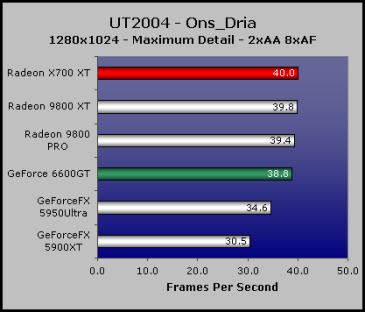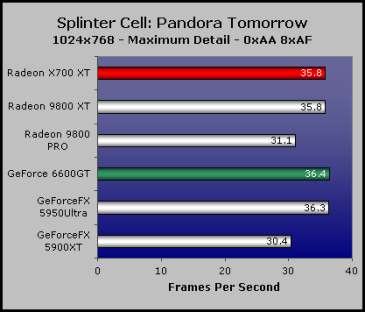Unreal Tournament 2004 - Onslaught
Publisher: Atari

Catalyst AI has really done a great job in this title. If we were only looking at the top four results in the graph, you would assume that there is a CPU limitation in this title. Well, this isn't quite the case, as both the GeForceFX 5950Ultra and GeForceFX 5900XT show a considerable drop in frame rate at this resolution - it drops enough for the GeForceFX 5900XT to be verging on unplayable.
The X700 XT has the lead overall, but by a very small margin - the extra frame buffer on the 9800 XT does not appear to make any difference. The X700 XT lacks the frame buffer to run with 4xAA though, in saying that though, the lack of memory bandwidth wouldn't necessarily mean that the board would be able to run with 4xAA if it featured a 256MB frame buffer. The ideal setting for the X700 XT is the same as the GeForce 6600GT - 1280x1024 with 2xAA, 8xAF will give a combination of a playable and good-looking game experience.
Splinter Cell: Pandora Tomorrow
Publisher: Ubisoft

Splinter Cell: Pandora Tomorrow was originally created for the Xbox and then ported over to the PC, and it's based around an NVIDIA-specific code path that makes use of the Unreal engine. Ubisoft added in extra, more improved lighting, which can provide some of the best looking real-time shadows with the exception of Doom 3. NVIDIA's boards make use of the buffered shadowing technique that provides superior image quality to the way that ATI are rendering the title with the DirectX backdoor that allows them to run projector shadows. Despite the game not being able to use Anti-Aliasing due to the title making use of post-filtering effects such as night vision and thermal vision, it still proves to be a very graphic-intense title.
Catalyst AI helps to regain some of the performance that seemed to be missing on ATI boards in general. If we remember back to Catalyst 4.6, there was a huge bug in the drivers, which was subsequently fixed in Catalyst 4.7 - this came accompanied with a drop in performance that really gave NVIDIA an advantage in this title. The X700 XT and 9800 XT aren't quite up to the performance levels of their NVIDIA counterparts, but the gap is certainly not as large as what it has previously been - this is all down to the way that the new Catalyst AI texture calculation method makes the best use of ATI's fast geometry pipeline as opposed to using NVIDIA's favoured texture lookup method via a DirectX backdoor.
Publisher: Atari

Catalyst AI has really done a great job in this title. If we were only looking at the top four results in the graph, you would assume that there is a CPU limitation in this title. Well, this isn't quite the case, as both the GeForceFX 5950Ultra and GeForceFX 5900XT show a considerable drop in frame rate at this resolution - it drops enough for the GeForceFX 5900XT to be verging on unplayable.
The X700 XT has the lead overall, but by a very small margin - the extra frame buffer on the 9800 XT does not appear to make any difference. The X700 XT lacks the frame buffer to run with 4xAA though, in saying that though, the lack of memory bandwidth wouldn't necessarily mean that the board would be able to run with 4xAA if it featured a 256MB frame buffer. The ideal setting for the X700 XT is the same as the GeForce 6600GT - 1280x1024 with 2xAA, 8xAF will give a combination of a playable and good-looking game experience.
Splinter Cell: Pandora Tomorrow
Publisher: Ubisoft

Splinter Cell: Pandora Tomorrow was originally created for the Xbox and then ported over to the PC, and it's based around an NVIDIA-specific code path that makes use of the Unreal engine. Ubisoft added in extra, more improved lighting, which can provide some of the best looking real-time shadows with the exception of Doom 3. NVIDIA's boards make use of the buffered shadowing technique that provides superior image quality to the way that ATI are rendering the title with the DirectX backdoor that allows them to run projector shadows. Despite the game not being able to use Anti-Aliasing due to the title making use of post-filtering effects such as night vision and thermal vision, it still proves to be a very graphic-intense title.
Catalyst AI helps to regain some of the performance that seemed to be missing on ATI boards in general. If we remember back to Catalyst 4.6, there was a huge bug in the drivers, which was subsequently fixed in Catalyst 4.7 - this came accompanied with a drop in performance that really gave NVIDIA an advantage in this title. The X700 XT and 9800 XT aren't quite up to the performance levels of their NVIDIA counterparts, but the gap is certainly not as large as what it has previously been - this is all down to the way that the new Catalyst AI texture calculation method makes the best use of ATI's fast geometry pipeline as opposed to using NVIDIA's favoured texture lookup method via a DirectX backdoor.

MSI MPG Velox 100R Chassis Review
October 14 2021 | 15:04






Want to comment? Please log in.